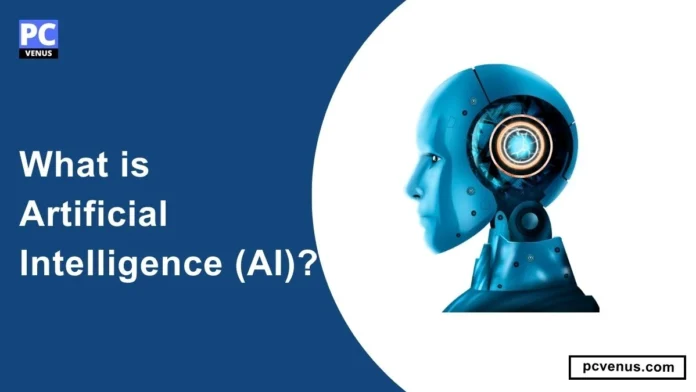In today’s digital age, the term “Artificial Intelligence” or AI has become common. It is no longer limited to science fiction; artificial intelligence is changing our lives in every possible way.
In this comprehensive guide, we’ll take a deep dive into the world of artificial intelligence, answering essential questions: What it’s all about?
What is AI?
Artificial intelligence (AI) enables computers to mimic human intelligence, handling tasks such as understanding language, problem-solving, and pattern recognition. Through machine learning, a subset of artificial intelligence, systems can adapt and make decisions without being explicitly programmed.
History of AI
1. Ancient Roots
Ancient civilizations, like ancient Egypt and Greece, mentioned creating mechanical automata resembling humans or animals in myths and legends, tracing the concept of artificial beings back to those times. However, these early inventions were more mechanical than intelligent.
2. Birth of Modern AI
The field of AI as we know it today was born in the 1950s. In 1950, Alan Turing proposed the idea of a thinking machine. He developed the famous “Turing Test” to evaluate a machine’s ability to exhibit intelligent behavior indistinguishable from a human’s.
In 1956, the Dartmouth Conference marked the official birth of AI as a field of research and brought together leading researchers to explore the possibilities of creating intelligent machines.
3. Early AI Approaches
In the late 1950s and early 1960s, AI research focused on rule-based systems and symbolic reasoning. The Logic Theorist, developed by Allen Newell and Herbert A. Simon in 1956, is considered the first AI program capable of proving mathematical theorems.
4. Knowledge Representation and Expert Systems
In the 1970s and 1980s, research shifted towards knowledge representation and expert systems. These systems aimed to capture and utilize the knowledge of human experts in specific domains. Notable examples include MYCIN, an expert system for medical diagnosis, and DENDRAL, a system for chemical analysis.
5. Neural Networks and Machine Learning
In the 1980s and 1990s, interest in neural networks and machine learning was resurgent. Backpropagation, a learning algorithm for training neural networks, was developed in the 1980s, leading to significant advancements in pattern recognition and speech recognition.
6. Rise of Big Data and Deep Learning
In the 2000s, the availability of massive amounts of data and computational power led to the rise of deep learning. Deep neural networks with many layers could automatically learn hierarchical representations of data, leading to breakthroughs in image and speech recognition, natural language processing, and other AI applications.
7. Current Developments
In recent years, AI has made significant advancements in various domains
The history of artificial intelligence (AI) can be organized into several key milestones and developments, which I will now show you in chronological order:
1. Dartmouth Conference (1956): Considered the birth of AI, the Dartmouth Conference brought together a group of researchers who coined the term “artificial intelligence” and laid the foundation for future AI research.
2. Logic Theorist (1956): Developed by Allen Newell and Herbert A. Simon, Logic Theorist became the first computer program capable of proving mathematical theorems.
3. General Problem Solver (GPS) (1957): Also developed by Allen Newell and Herbert A. Simon, GPS was an AI program designed to solve many problems using heuristics and problem-solving techniques.
4. ELIZA (1966): Created by Joseph Weizenbaum, ELIZA was a computer program capable of mimicking a conversation with a human using pattern matching and scripted responses. It is considered one of the first chatbots.
5. Shakey the Robot (1969): Developed at Stanford Research Institute, Shakey was one of the first mobile robots capable of navigating its environment and performing tasks autonomously, demonstrating the potential of AI in robotics.
6. Expert Systems (1970s-1980s): Expert systems emerged as a popular AI technology. These systems used rule-based reasoning to mimic the decision-making process of human experts in specific domains, such as healthcare and finance.
7. Backpropagation Algorithm (1986): The backpropagation algorithm, independently developed by Geoffrey Hinton and Yann LeCun, revolutionized the field of neural networks and enabled significant advancements in machine learning.
8. Deep Blue vs. Garry Kasparov (1997): IBM’s Deep Blue supercomputer defeated world chess champion Garry Kasparov, showcasing the power of AI in strategic decision-making and complex problem-solving.
9. Watson (2011): Developed by IBM, Watson demonstrated the potential of AI in natural language processing and knowledge-based systems by winning the Jeopardy! Game show against human champions.
10. AlphaGo (2016): Developed by DeepMind Technologies (a subsidiary of Alphabet Inc.), AlphaGo became the first AI program to defeat a world champion Go player, highlighting AI’s ability to master complex games through reinforcement learning.
These are just a few key milestones and developments in the history of AI. The field continues to evolve rapidly, with advancements in machine learning.
Types of AI
Several types of AI can be classified based on their capabilities and functionalities. Here are some common types of AI
1. Narrow AI
Also known as weak AI, narrow AI refers to AI systems designed to perform specific tasks or solve problems. These systems are focused and specialized in their abilities and cannot generalize or perform tasks outside their particular domain.
Examples: Voice assistants like Siri or Alexa, recommendation systems, and image recognition algorithms.
2. General AI
The General AI, also known as strong AI or AGI (Artificial General Intelligence), refers to AI systems that possess human-level intelligence and are capable of understanding, learning, and performing any intellectual task that a human can do. General AI remains a theoretical concept and is yet to be achieved.
3. Machine Learning
The Machine learning is a subset of artificial intelligence that teaches computers to use data to learn and make predictions or decisions without being explicitly programmed.
Machine learning algorithms can analyze and learn from large amounts of data to identify patterns, make predictions, or automate tasks.
Examples: Image and speech recognition, natural language processing, and recommendation systems.
Also Read: Best Laptops for Deep Learning, ML and AI
4. Deep Learning
Deep learning is a subfield of machine learning that focuses on multi-layered artificial neural networks (deep neural networks). These networks can learn and extract complex patterns and representations from data.
Deep learning has made breakthroughs in image and speech recognition, natural language processing, and autonomous driving.
5. Reinforcement Learning
Reinforcement learning involves training AI systems to make decisions and act in an environment to maximize a reward or achieve a specific goal. The AI system learns through trial and error, receiving feedback through rewards or penalties based on its actions.
Reinforcement learning has been successfully applied in game-playing AI, robotics, and optimization problems.
6. Expert Systems
Expert systems are AI systems that mimic human experts’ knowledge and decision-making abilities in specific domains. These systems use rules and logic to provide expert-level advice or make decisions in their respective fields. Expert systems have been used in medical diagnosis, financial analysis, and customer support.
The field of AI is vast and continues to evolve, with new techniques and approaches being developed to tackle various problems and challenges.
Benefits of AI
Artificial Intelligence (AI) offers numerous benefits across various fields and industries. Some of the key benefits of AI include:
1. Automation and Efficiency
AI can automate repetitive and mundane tasks, allowing human workers to focus on more complex and creative work. This increases efficiency and productivity, as AI systems can perform tasks faster and with a lower error rate than humans.
2. Improved Decision Making
AI systems can analyze vast data and provide insights to support decision-making processes. AI can help businesses and organizations make more informed and data-driven decisions by processing and interpreting data more quickly and accurately than humans.
3. Enhanced Customer Experience
AI-powered chatbots and virtual assistants can provide personalized and efficient customer support by responding to inquiries, solving problems, and providing recommendations. This leads to improved customer satisfaction and a better overall experience.
4. Increased Safety and Security
AI can be utilized in various applications to enhance safety and security. For example, AI-powered surveillance systems can analyze video footage in real-time to detect and alert authorities of potential threats or suspicious activities. AI can also be used in cybersecurity to identify and respond to potential threats or vulnerabilities.
5. Improved Healthcare
AI has the potential to revolutionize healthcare by enabling faster and more accurate diagnosis of diseases, identifying patterns in medical data, and assisting in the development of personalized treatment plans. AI can also help streamline administrative tasks in healthcare facilities, reducing paperwork and improving operational efficiency.
6. Advancements in Transportation
AI is crucial in developing autonomous vehicles, leading to safer and more efficient transportation systems. AI algorithms can analyze sensor data and make real-time decisions to navigate and react to changing road conditions, reducing accidents and congestion.
7. Innovation and Discovery
Artificial intelligence drives scientific innovation by analyzing complex data and helping to achieve breakthroughs in drug discovery, materials science, and climate modeling. It transforms industries, automates tasks, and enhances decision-making. Ethical and responsible use of artificial intelligence is critical to maximizing benefits and minimizing risks.
Risks of AI
Artificial intelligence (AI) brings numerous benefits and opportunities but presents certain risks and challenges. Here are some of the risks associated with AI:
1. Job displacement
AI technologies, such as automation and robotics, can potentially replace human workers in various industries, leading to job losses and economic disruption. This could disproportionately affect individuals in low-skilled or routine-based jobs.
Also Read: Best Laptops for Freelancers and Online Jobs
2. Bias and discrimination
AI systems can inherit and perpetuate biases in the data used to train them. If the training data is biased or reflects societal prejudices, AI algorithms may make biased decisions, leading to discrimination in hiring, lending, and criminal justice areas.
3. Privacy and security concerns
AI systems often rely on extensive data collection and analysis, raising concerns about the privacy and security of personal information. Unauthorized access to AI systems or misusing AI-generated data can have serious consequences, including identity theft and individual privacy breaches.
Also Read: Best Laptops for Cyber Security [Hacking]
4. Ethical considerations
AI raises ethical questions regarding using AI systems in healthcare, autonomous weapons, and surveillance. Decisions made by AI algorithms may conflict with human values and raise concerns about accountability, responsibility, and transparency.
5. Unemployment and economic inequality
The increasing automation of tasks through AI can lead to significant unemployment, particularly for individuals in certain sectors or with specific skill sets. This may contribute to economic inequality and social unrest if not adequately addressed.
6. Technological singularity
Some researchers and experts speculate about the possibility of a future scenario in which AI surpasses human intelligence, known as the technological singularity. This raises questions about control and the potential implications and consequences of creating AI systems that are more intelligent than humans.
7. Lack of transparency and understanding
As AI becomes more complex and sophisticated, it can become challenging to understand and explain how AI systems reach their conclusions or make decisions. This lack of transparency can undermine trust and hinder addressing potential biases or errors.
Real-World Applications of AI
Indeed, AI has made significant contributions to various industries and sectors. Here are some real-world applications of AI in different domains:
1. Healthcare
AI is used in healthcare for various applications, including medical imaging analysis, diagnosis and treatment recommendation systems, personalized medicine, drug discovery, and patient monitoring. AI algorithms can analyze medical images, such as X-rays and MRI scans, to assist in detecting diseases and abnormalities.
2. Finance
AI is employed in the finance industry for fraud detection, risk assessment, algorithmic trading, and customer service tasks. Machine learning algorithms can analyze vast amounts of financial data to identify patterns, predict market trends, and make informed investment decisions.
Also Read: Best Laptops for Finance Students
3. Transportation
AI plays a crucial role in autonomous vehicles, optimizing traffic flow and predicting traffic patterns. AI-powered systems are also used in logistics and supply chain management to optimize routes, reduce costs, and improve delivery efficiency.
4. Entertainment and Gaming
AI is used in the entertainment industry to enhance user experiences and create personalized recommendations. It powers recommendation systems on streaming platforms, voice assistants in smart speakers, and chatbots in customer service. Additionally, AI is used in game development to create intelligent non-player characters (NPCs) and improve gameplay experiences.
5. Educational Sector
AI is being applied in education to personalize learning experiences, provide adaptive learning solutions, and assist in grading and assessment. AI-powered educational platforms can analyze student data to identify strengths and weaknesses and tailor educational content accordingly.
The potential of AI continues to grow, and its applications are expanding into new areas, revolutionizing industries and improving efficiency and productivity.
The Future of AI
The future of AI holds great potential and promise, but it also raises important questions and considerations. As AI continues to advance, it is expected to profoundly impact various aspects of society, including industries, healthcare, transportation, and communication.
One area of development is in the field of autonomous vehicles. The use of AI in self-driving cars has the potential to revolutionize transportation by improving safety and efficiency. However, questions regarding liability, ethical decision-making in critical situations, and the impact on jobs in the transportation sector need to be addressed.
AI is also expected to play a significant role in healthcare, assisting with diagnosis, treatment planning, and drug discovery. While this can lead to improved healthcare outcomes, concerns around data privacy, algorithmic bias, and the potential for AI to replace human healthcare professionals need to be carefully considered.
In the workplace, AI has the potential to automate routine tasks, increasing productivity and efficiency. However, this also raises concerns about job displacement and the need for workers to develop new skills to adapt to the changing nature of work.
Ethical considerations in AI development and deployment are of utmost importance. People are working hard to make AI systems open, accountable, and fair. This means fixing algorithm biases, using data responsibly, and considering how AI might affect society.
As AI advances, it’s crucial for everyone—policymakers, researchers, industry experts, and the public—to talk and work together. This collaboration helps ensure AI benefits society while minimizing risks by addressing ethical and social concerns.
Final Words
AI is a transformative force that is reshaping industries and our daily lives. It is essential to understand “What is AI” and its potential benefits and challenges. As AI advances, embracing its possibilities while addressing ethical concerns will be crucial. Stay tuned for the exciting developments that the future of AI holds.
FAQs
Is AI safe?
AI can be safe if designed carefully, free from bias, and regularly monitored. It depends on how we use and control it. We must ensure it’s fair, transparent, and doesn’t compromise privacy or security. It’s like a tool; its safety depends on how we use it and look after it.
Can AI replace human jobs?
Yes, AI can replace some human jobs, mainly routine and repetitive tasks, but it can also create new jobs in AI-related fields.
Can AI control humans?
No, AI cannot control humans on its own. Humans control and program AI systems.
How can I start learning AI?
To start learning AI, you can:
i. Take online courses (e.g., Coursera, edX).
ii. Learn programming languages like Python.
iii. Study AI books and tutorials.
iv. Join AI communities and forums.
v. Work on AI projects to practice.
What are the current trends in AI?
Current trends in AI include:
i. AI in Healthcare
ii. AI in Automation
iii. Natural Language Processing
iv. AI Ethics
v. AI in Finance
vi. AI in Autonomous Vehicles
vii. AI in Education
viii. AI in Customer Service
ix. AI in Agriculture
x. Quantum AI
Can AI predict the stock market?
AI can help analyze stock market data and make predictions, but it’s only sometimes accurate because many unpredictable factors influence financial markets.
Can AI predict the future?
No, AI cannot predict the future with certainty. It can make forecasts based on data and patterns, but future events are uncertain and can’t be predicted accurately.




